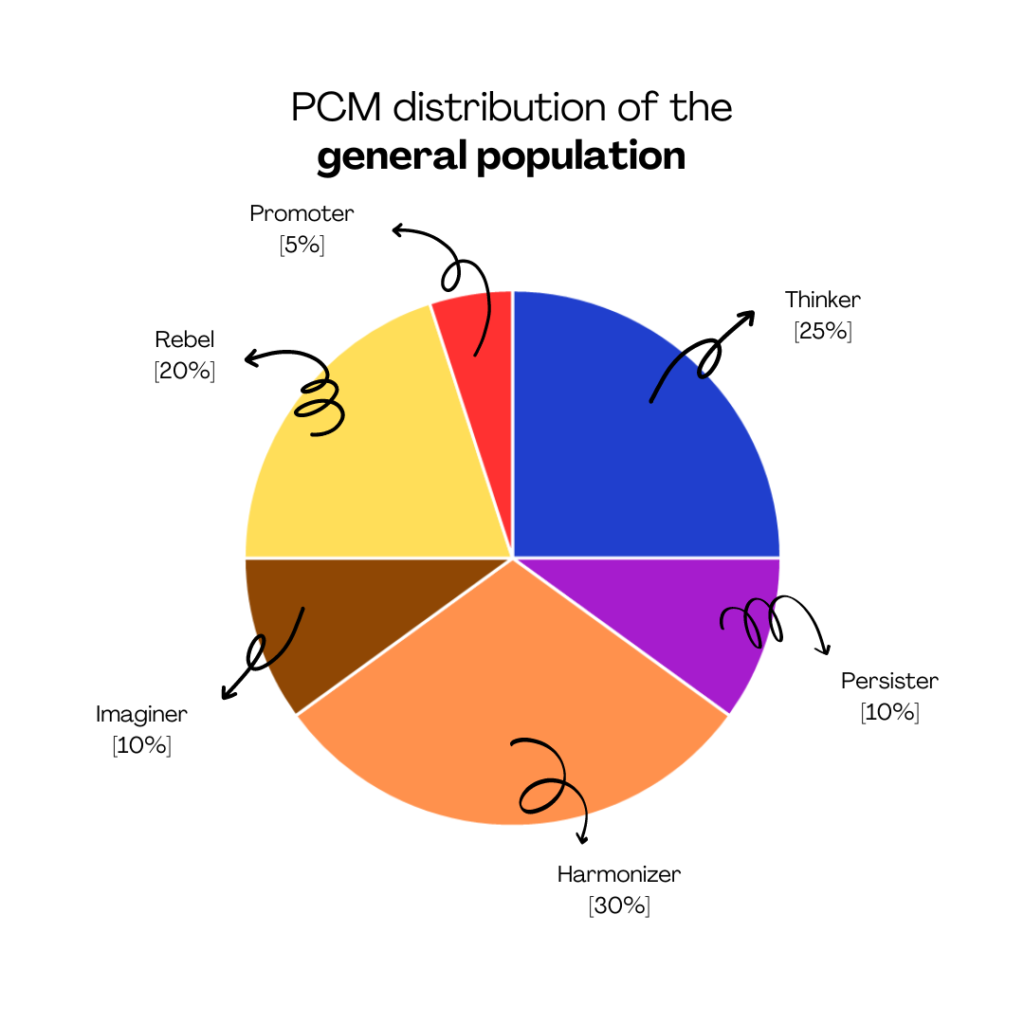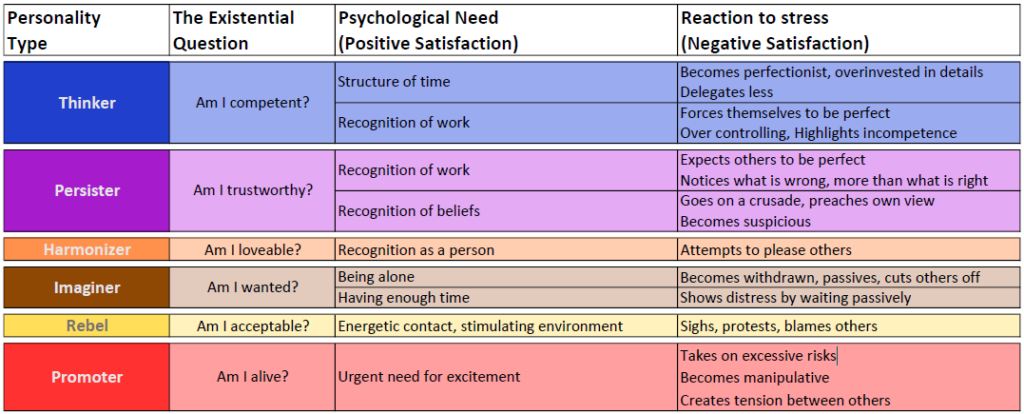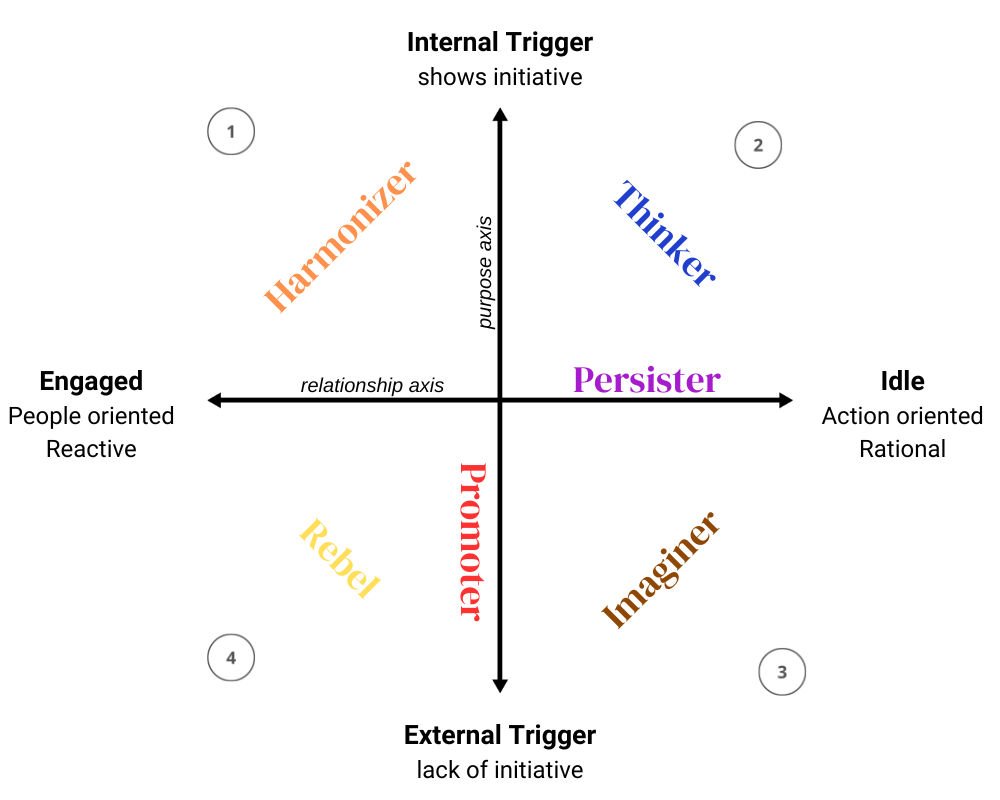Do you ever feel like you’re speaking different languages with different people?
Have you ever wondered why you click with some colleagues but clash with others?
If you imagine a world where you can effortlessly navigate any conversation, I have fantastic news for you! There is a powerful tool that can help you understand yourself and those around you better. This tool is called the Process Communication Model, or more simply put: PCM.
The PCM model, developed by Dr. Taibi Kahler, identifies six fundamental personality types, each with unique needs, motivations, and communication styles. By understanding your own type and those of others, you can adapt your approach for better interactions.
The model has been researched and developed for more than 40 years, during which people began to use it in business, politics, education and even NASA has applied it in the selection of the astronauts for manned space flights between 1959 and 1996. If you wonder why they stopped using it… it is not because it doesn’t work, but because they have further developed their own proprietary model in-house.

If you want to share our message successfully, first you need to find the right language for communicating it. What’s nice about this model, is that it doesn’t put people in boxes, but rather recognizes that we all have all the 6 personality types within us. Just imagine it like a 6-story building.
Different individuals might say the below. In the interest of successful communication it is recommended to reply appropriately, based on their personality types:
- I am interested in talking about facts and information –> let’s talk facts
- I talk from my heart and share my feelings with you –>let’s touch base on how do we feel about things, be companionate, focus on relationships
- I say what I like and what I don’t like! –> let’s be straight
- I have an opinion about this and values are important to me –>let’s understand values and acknowledge beliefs
- I reflect upon things –> let’s take time and imagine a future state, analyze deeply
- I am action oriented. Enough talk, let’s do something about it –> let’s make a plan and execute it
There are different ways to try to determine one’s personality type.
To determine your own Base, you can either take the official and paid PCM test, guided by an official PCM trainer or coach or chose the cheaper route and put in some effort while also exercising self-awareness. In this article we will explore 2 angles aiming to guide you in identifying your own personality type and that of the people you are communicating with. In each section, I will also include examples to make it easier for you to discern between the different types.
What to expect in this article?
In the next sections you will:
- Understand the psychological needs of each personality type and observe how each of them reacts to stress
- Have a look at the identification matrix, that represents the 6 personality types in a visual manner
Finally, we flip the view and create a summary by personality types.
By the end of this article, you will learn to recognize and differentiate these types in the people you are communicating with. If you want to get your message across, you need to focus on what the other person listens to and understands, rather than focusing on yourself, your style, and what feels natural to you.
The Basics of PCM
The PCM model acknowledges that we all have all 6 personality types layered within us. Imagine it like a 6-story building. At the ground floor we have our Base personality type. This is the one we are born with and according to study, develops and sets in during the first few weeks after we are born. During our life, the Base will be constant, a type that we feel good with and that comes naturally.
The Base is what determines an individual’s strengths, characteristics, psychological needs, and foretells the most probable reactions triggered by stress. The Base comes so naturally, that the best way to determine you own type is to observe yourself during stress conditions. When exposed to stress, people go back to their basic instincts and the way they act and talk when under pressure represents their Base personality type.
Beside the Base, we also have a Phase. Think about the Phase as one of the other floors inside the 6-story building. Sometimes you are at the ground floor (Base), other times you are at a different floor (Phase). While the Base will remain constant, the Phase might (in 66% of the population it does) change during a lifetime.

When communicating with others, the further you are from your Base, the more energy and self-control it requires to communicate effectively. The ability of consistently communicating in a different style that is not one’s Base or Phase (they might or might not be the same), is greatly increased by the level of emotional intelligence a person has.
The Six personality types defined by Dr. Taibi Kahler are: Thinker, Persister, Harmonizer, Imaginer, Rebel, and Promoter. This is in no particular order; it is just the way I find it logical to structure it 😉.
Explore the psychological needs of each personality type and observe how each of them reacts to stress
Satisfying one’s psychological needs is the main source of motivation for each type, and the energy level throughout the day is closely linked to it. If you are a leader / manager / coordinator or just simply in need of having people around you respond positively when communicating with you, I strongly recommend to take a look at the below summary and try to find the Base of the person you are about to have an interaction with.
Remember, that negative attention is also a kind of attention, but you don’t want to build on that!

Thinker – Asking the existential question: “Am I competent?”
The Thinker has an increased need to have their work recognized, constantly trying to answer the question if they are or aren’t competent enough. If you are a manager of a Thinker based contributor, appreciate their skills and work put into delivering a task. You should do it in a structured manner, focusing on data, facts and logic. The Thinker will not be impressed by small talk and getting sentimental about the work or the relationship. Hence, they can sometimes be perceived as cold and distant individuals, especially by people with Base Harmonizer profiles.
People with Thinker traits have excellent analytical minds. Before jumping to conclusions or solving a problem, they will first investigate, gather all information and make a conscious and well documented decision. This positive trait can also transcend into a negative one. While the Thinkers gather large amounts of data, sorting and analyzing it, they are sometimes afraid of taking risks. This is hidden behind the thought that there might not be enough information available to make a well-documented decision.
Under stress, the Thinker will become overinvested in details and a perfectionist. When this trait is present in a manager, it might translate into not delegating to team members anymore and doing all the work by themselves. Saying: “I need to be fast; I cannot waste any time by explaining to them what they need to do. Better if I do it myself!”
Due to their increased sense of responsibility, investment in work, way of being and their need of structure and logic, they are often very appreciated by management.
It is estimated, that 25% of the population has a Thinker Base (75% men, 25% women).
Persister – Asking the existential question: “Am I trustworthy?”
Although very similar to the Thinker, the Persister perceives the world through their own beliefs, filters and values. People who have the Persister traits, will often give out unsolicited advice about how things “should be”.
Due to their conviction that they are in possession of the ultimate truth and the one single way of doing things properly, Persisters will be very dedicated in their lines of work. No extra incentives will be needed for them to do a great job. As a manager (or even spouse, and I am talking from experience here) you can use this obsession of the Persister to your own benefit. Instead of stating your wishes, ways of working, action to be taken; try to make the Persister reach the same on their own. Once the conclusion is self-reached, (almost) nothing will stop them from executing.
While the Thinker needs to be recognized for their achievements, the Persister gets energized by having a valuable contribution in a group. They also need to be recognized for their opinion. That doesn’t mean you always need to be in agreement with them. They react well to structed and logical debates and their minds can be changed by proper arguments. You might hear them say: “Prove me wrong!”
Under stress, the Persister will expect others to be perfect and will often focus on identifying what goes wrong instead of what goes right. If you fail to offer the right recognition, they will go out on a crusade and make it their life goal to prove you wrong.
Because of their powerful convictions, you will often find this personality trait high in hierarchies, amongst politicians, military, religious leaders and even humanitarian organizations.
It is estimated, that 10% of the population has a Persister Base (75% men, 25% women).
Harmonizer – Asking the existential question: “Am I loveable?”
The Harmonizer, similarly to the Thinker and Persister; is driven by an internal purpose. But while the Thinker and Persister are logical and action oriented, the Harmonizer is oriented and invested in having good relationships.
When a Harmonizer Base asks you “How are you?” you can be sure there is genuine interest behind the question. They need close interpersonal relationships in order to feel motivated and energized and will filter the world through the lens of emotions.
Because of their increased need to be liked and loved, they have a hard time saying NO and will do pretty much anything to please the other person. Even if this comes at great personal cost.
Under stress, the Harmonizer will try to adapt to the situation, always having in mind the need of being loved and to please others. They will use words that don’t offend people they are interacting with: “May I have a suggestion?”
It is estimated, that 30% of the population has a Harmonizer Base (75% women, 25% men).
Imaginer – Asking the existential question: “Am I wanted?”
The Imaginer is the loner, that deep down is action oriented but gets stuck in “analysis paralysis”. Analyzing and over analyzing each and every scenario over and over again in their mind. They like to undertake their deep thinking in solitude and tend to stay in a state of inaction, unless an external force invites and incentivizes them to take action.
The Imaginer type person is the one that will e-mail you a question and fail to reply to your answer. Not because they are rude, but because they go into full analysis mode and they seldom tend to reach a final decision. If you want to see progress when working with an Imaginer, you need to set clear guidelines that will not allow the Imaginer the freedom to decide the timeline and actions by themselves. Instead of agreeing that they reach out when they are done, you should set a clear expectation: “Let’s reconvene on Thursday, 10AM”. This direct approach with handing out clear instructions works well with Imaginer profiles and helps them manage the stress caused by their innate need of deep thinking.
Because they perceive the work through the filters of imagination, outside people tent to regard them as “daydreamers” although inside them there is a lot of action going on.
Due to their traits, Imaginers works well alone and at their own pace, but need an external force that shows them that they are wanted.
Under stress, the Imaginer will be even more quiet and withdrawn and will go into a state of passively waiting. At the workplace they tend to take on several projects at the same time but often fail to finalize them. If you have an Imaginer in your team, make sure you pay attention to their workload, as they seem not to be able to properly estimate the volume they can carry.
It is estimated, that 10% of the population has an Imaginer Base (60% women, 40% men).
Rebel – Asking the existential question: “Am I acceptable?”
People with Rebel Base need constant energetic contact and work best in a stimulating environment. You can be fairly sure, that the Rebels home will not be designed in line with the minimalist movement and in beige tones. They perceive the world through the filter of their reactions: “I like / I don’t like” and they probably are innate impulse buyers.
Rebels love to use interjections, so you will often hear them saying: “Awesome”, “Wow”, “Yikes”, “Whoaaa”, “Hmm”.
As part of their personality traits, Rebels tend you speak loud and clear whatever they are thinking, often irrespective of the consequences. They are doing it to test out their existential question of being accepted by the people around them.
Under stress, the Rebel will insist that they suddenly don’t understand what is going on and will invite others to think instead of them. They will say things like: “I don’t get it!”, “This is to complicated for me, I don’t understand”. “Huh?”. They also tend to blame others instead of accepting their own fault: “If it is not ready by the deadline, it has nothing to do with me! You have set this priority!”.
It is estimated, that 20% of the population has a Rebel Base (60% women, 40% men).
Promoter – Asking the existential question: “Am I alive?”
The Promoter perceives the world though the filter of action and they need to be constantly on the move, doing something, staying busy. They are not interested in the “why” of their actions, there just should be an action going on. Because of this trait, they show a massive capacity of adapting to various situations.
The Promoter profile enjoys challenges and needs to see immediate results. As a manager you just need to set the goal and they will go for it blindly, versus the Persister where an immense work of convincing precedes every action.
Under stress, when the Promoter senses lack of action, they will undertake unnecessary risks for their health, wealth, safety, just for the thrill if action. They also tend to create artificial conflicts between people, just to see some action going on. They are the ones that start gossips, take out their popcorn and enjoy the show.
It is estimated, that 5% of the population has an Imaginer Base (60% men, 40% women).
The Personality Type Identification Matrix
No matter how complex a subject, you can always represent it on a chart!
Although this might look complicated at first, I promise it is not.

Let’s dive in an dissect each quadrant by its inhabitants.
Q1: Internally motivated and showing initiative, while being people oriented and reactive
This is the home base of the Harmonizer:
- Interested and invested in human relationships
- Gets sad during conflict, hence being afraid of it and avoiding it
- Enjoys being part of a group and constantly searches the company of other people
- Gets energized by human interactions
- Recharges during a coffee break, while surrounded by other people
- Takes initiative in interactions
- Has the need and creates personal connections, ask “Where are you from?”
Q2: Internally motivated and showing initiative, while being action oriented and idle in relationships
This quadrant gives home to 2 types: Thinker and Persister.
Although they are very much alike, the major differentiator lies in their belief systems. The Thinker prefers facts, while the Persister has some stone clad built-in ideas and convictions that no one can ever refute.
You are dealing with a Thinker if the person in front of you:
- Goes right to the point
- Is preoccupied with efficiency
- Prefers individual relationships over larger groups
- Is in constant search for information and is often offering information (sometimes with too many details)
- Wants to show competence and an expertise
- Optimizes time and has an increased need for punctuality
If you are noticing the following, you are communicating with a Persister:
- Engaged in their own ideas instead of relationships
- Not affected by conflict
- Preoccupied with efficiency
- When communicating, interested in other people’s opinions (rather than objective facts)
- Wants to be with a group, not in the group
- Before communicating, they pre-create their own point of view and opinion about the topic in question
Q3. Externally motivated, without showing initiative & action oriented
Alone in this quadrant resides the Imaginer.
This personality type is:
- Distant, appears to be not interested and invested in relationships
- Often poses like a victim, waiting to be addressed instead of making the first step
- Needs extended time to analyze and think
Q4. Externally motivated and people oriented
Finally, we have arrived to the “bad boys” of PCM: the Rebel and the Promoter.
The Rebel:
- Connects with otherx as a result of an external stimuli
- Reacts openly to feelings
- Appreciates the “here & now”
The Promoter:
- Launches into action as a result of an external stimuli
- Has an increased need for action, for something to happen
- Uses external factors (connections, relations) to get in touch with other people. “I also like XYZ shoes”, “I am also driving XYZ car”
- Creates the feeling that they are driving the discussion
- They agree with whatever its being discussed. “yes, you are right”, “Of course, don’t worry”
Summary by PCM profiles
The Thinker – Summary

Thinker – General
- Seeks answer to the question: “Am I competent?”
- Starts by thinking, searches for facts and information that a decision / action can be based on
- Organizes data, processes, schedules
- Avoids improvisation, doesn’t feel good being spontaneous
- It’s not easy to make a Thinker smile
- Lives in a well-organized and functional environment
- Everything has it’s assigned place and location, there’s a method to the madness
- Prefers contemporary house designs, adopts technology
- Tends to forget that there is life outside work, might get workaholic and burn out
- Relaxing is a waste of time
- If professional life doesn’t offer enough recognition of work and satisfaction, the Thinker will develop a hobby and will focus on it instead of work
Thinker – Characteristics
- Strengths: logic, sense of responsibility, organization
- Lifestyle: contemporary, organized, functional
- Perception: analyzes, organizes into categories
- In teams: exchanges information, prefers small group interactions
Thinker – Signs
- Considers meetings are too long
- Gets annoyed if meetings don’t result in clear actions
- Complains about lack of evolution
- Needs a firm and direct manager
- Cannot leave the office until the job is done
Thinker – Needs
- Recognition of work
- “This report looks as expected”
- “I appreciate the quality of your work”
- Needs recurring feedback
- Structure of time
- “By when can this be done?”
“How much time does this take?”
- “By when can this be done?”
Thinker – Negative Satisfaction / Stress reaction
- Gets inflexible in thinking
- Gets stubborn and works towards being perfect, adds extra details, controls each movement with precision
- Stops delegating
Famous Thinkers:
- Spock & Data from the Start Trek series
- Hercule Poirot from Agatha Christies novels
- Sherlock Holmes
- Chuck Noland (played by Tom Hanks) in the movie Cast Away
The Persister – Summary

Persister – General
- Sharp sense of observation
- High expectations set for themselves and people around them
- Sharing own values and beliefs is a personal mission
- Once a goal has been set, it must be accomplished!
- Hates being interrupted while working
- Searches for opinions vs the Thinker, who searches facts
- Interprets rather than analyzes
- Finds it hard to listen to other people, the Persister likes to talk and share own ideas
- Likes to collect old, antique stuff
- Needs a lot of information to change their views
Persister – Characteristics
- Strengths: involvement, attention to details
- Lifestyle: capacity to formulate ideas and opinions
- Perception: judges based on own beliefs
- In teams: takes control, seeks to exchange ideas, prefers small group interactions
Persister – Signs
- When stressed, doesn’t listen to anyone else
- Says: “I am sure we need to do it this way”
- Says: “I believe that…”
Persister – Needs
- Recognition of work
- Recognition of beliefs
- The Persister listens to logic. If you disagree with a Persister, you should say: “I respect your opinion, but I don’t share it”
- You should state that you are interested in their opinions
- You should highlight that their opinions and suggestions are important to you
Persister – Negative Satisfaction / Stress reaction
- Anchors in own beliefs
- Becomes rigid and inflexible in thinking and communicating
- Pays attention to other people’s mistakes
- States: “I have demonstrated that…”
Famous Persisters:
- Hitler
- Martin Luther King
- Steve Jobs
- Shuji Nakamura, the inventor of the blue LED
The Harmonizer – Summary

Harmonizer – General
- Talks about themselves and touches personal topics
- Pays attention to those around them and values the quality of human relations
- Shows genuine interest towards others
- Works toward being liked by everyone
- Gets attached to physical objects, links memories to them
- Kind, compassionate, sensible
- Struggles to say “No”
- Finds it hard to set own limits
- In order to feel good in a team, they need a supporting and understanding manager, a team that is always cheerful
- Gets energized through senses: a good restaurant, a nice movie
Harmonizer – Characteristics
- Strengths: compassionate, sensible
- Lifestyle: creates harmony and pays attention to others needs
- In teams: searches to be an active part of teams, hates conflicts
Harmonizer – Signs
- Hates when not greeted in the mornings in the office
- Loves coffee breaks
Harmonizer – Needs
- Recognition as a person
- You might say to a Harmonizer profile: “I feel good when I am around you”, “How lucky we are to have you”
- Sensory needs
- Nice colors
- Great music
- Sunshine
Harmonizer – Negative Satisfaction / Stress reaction
- Takes on too much
Famous Harmonizers:
- Rose Hsu Jordan (played by Rosalind Chao) in the movie The Joy Luck Club
- Princess Diana
- Charlotte (played by Kristin Davis) from Sex and the City
The Imaginer – Summary

Imaginer – General
- Full of ideas
- Avoids human interaction
- Lives a rich interior life
- Workplace is simple, the space is of little importance
- Great capacity for introspection
- As a manager, offers great deal of freedom, space to innovate and is open to suggestions
- Feels good when there is something specific to be taken care of
- Needs clear guidance
- Prefers peace and quite
Imaginer – Characteristics
- Strengths: calm, imaginative, reflective
- Lifestyle: simple
- In teams: reserved, doesn’t show initiative or initiates contact
Imaginer – Signs
- quiet
Imaginer – Needs
- Alone time
- Enough time
Imaginer – Negative Satisfaction / Stress reaction
- Takes on too many projects at once and fails to finalize them
- Gets depressed
- Retreats in their shell and waits passively
Famous Imaginers:
- Einstein
The Rebel – Summary

Rebel – General
- Outside general norms (original clothes, flexible schedule, having fun at any given time)
- Individualistic, but need a lot of human contact. Cannot stay happy by themselves
- Spontaneous, heart of the party
- Born with native creativity
- Isn’t motivated by self-development
- Wants to be able to freely express their ideas, to have their creativity accepted and recognized
- Gets easily bored by recurring activities
- Reacts openly to what they feel
- Lives in the moment, finds it hard to imagine the future (YOLO)
- When interacting with a Rebel, make sure to share some jokes along the discussion
Rebel – Characteristics
- Strengths: spontaneous, creative
- Lifestyle: original, nonconformist
- In teams: like to work with and be part of a team. Doesn’t show initiative but feels good when working with others
Rebel – Signs
- Will often say: “I am not in the mood”, “It’s so hard…”, “I have had enough of …”, “I start having a headache just when I think about…”
Rebel – Needs
- Constant contact and acceptance shown by others
Rebel – Negative Satisfaction / Stress reaction
- Complains a lot
- Accuses
- Shocks
Famous Rebels:
- Robbie Williams
The Promoter – Summary

Promoter – General
- Enjoys actions, cannot stay put
- Likes luxury items, speed, games, exquisite holidays
- Dives head first, without proper thinking
- Searches for adrenaline
- Lives for the moment
- Makes friends easily and everywhere, but finds it hard to maintain relationships
- Needs a manager that gives them freedom
- Prefers firm tone and direct discussions
Promoter – Characteristics
- Strengths: adaptable, charming, persuasive
- Lifestyle: luxury, expensive, grandiose
- In teams: prefers to act alone
Promoter – Signs
- Talks loads and always has breaking news to share or a gossip to pass on
- Attracts attention to own person
Promoter – Needs
- Excitement, new projects, rapid results
- Sport competitions
- Adventure
Promoter – Negative Satisfaction / Stress reaction
- Manipulates
- Disturbs others well-being
- Takes on excessive risks
Famous Promoters:
- Jack Sparrow (played by Johnny Depp) in the Pirates of the Caribbeans series
- Harvey Specter (played by Gabriel Macht) in the Suits series
Situational Examples, with exaggerated reactions, that will help you discern between the profiles:
You have bought a new house and you are presenting it to 6 of your friends, all with a different Base. The reaction of each of them, based on their profile:
- Thinker: You have 3 children, a 4-bedroom house makes perfect sense.
- Persister: The kitchen and the living room should be separated by a wall.
- Harmonizer: What a nice big dinner table, perfect for a lovely meal together with your family.
- Imaginer: … quiet, looking around, deciding what to say.
- Rebel: Awesome!!! I love the kitchen cabinet colors! The Main bathroom is too small, I don’t like where the shower is situated.
- Promoter: Looks cool, now let’s go start the barbeque!
You are organizing a company team building and you are trying to decide the menu for the weekend:
- Thinker: We should stick to a basic standard menu for everyone. If someone has special dietary requirements, they should tend for themselves.
- Persister: I believe we should tend to everyone’s request, that’s how it should be done.
- Harmonizer: Poor vegans, what will they eat?
- Imaginer: We should not rush into a decision, we need to analyze in details what people would like to eat, asses the quantities and also think about a drinks list. And where everyone will sleep, and how do we get there, and …
- Reber: Yeah! We are going to paaartyy!
- Promoter: Let’s just go to the supermarket and we decide what to buy on the spot!
It’s time for the End of Year conversations and people start discussing at the office:
- Thinker: I have completed 88.3% of my goals, I expect I will be evaluated as XYZ and receive a merit increase of ABC%
- Persister: I have worked hard all year long and I should be rewarded for my extra efforts!
- Harmonizer: I feel so good about the past year. My boss is such a nice understand person, always asking me how I am doing.
- Imaginer: Doesn’t engage in the discussion. Passively waits for the meeting invite to arrive.
- Reber: Whoa! I just got a headache thinking about this discission! They constantly changed my priorities throughout the year. It’s not my fault I am late with project XYZ!
- Promoter: Just be done with it and move on to the next project
Conclusion
The Process Communication Model offers a comprehensive framework for understanding and improving communication dynamics. By diving into details about the personality types, understanding their communication styles, stress reactions and general characteristics, you are now better equipped to navigate interpersonal interactions effectively.
PCM can also serve as a powerful tool for resolving conflicts, reducing misunderstandings, and fostering a positive communication climate. Feel free to use it in collaboration with SCARF and non-violent communication techniques for better results.
In essence, the Process Communication Model offers a roadmap to effective communication, empowering individuals to navigate the complexities of human interaction with clarity and compassion.
Have fun trying to map your team, your family and friends to the 6 personality types. Use PCM in your everyday life:
- to better organize your time
- to add value to your projects
- to feel good about yourself and improve relationships
- to have fun
- to get fast results
